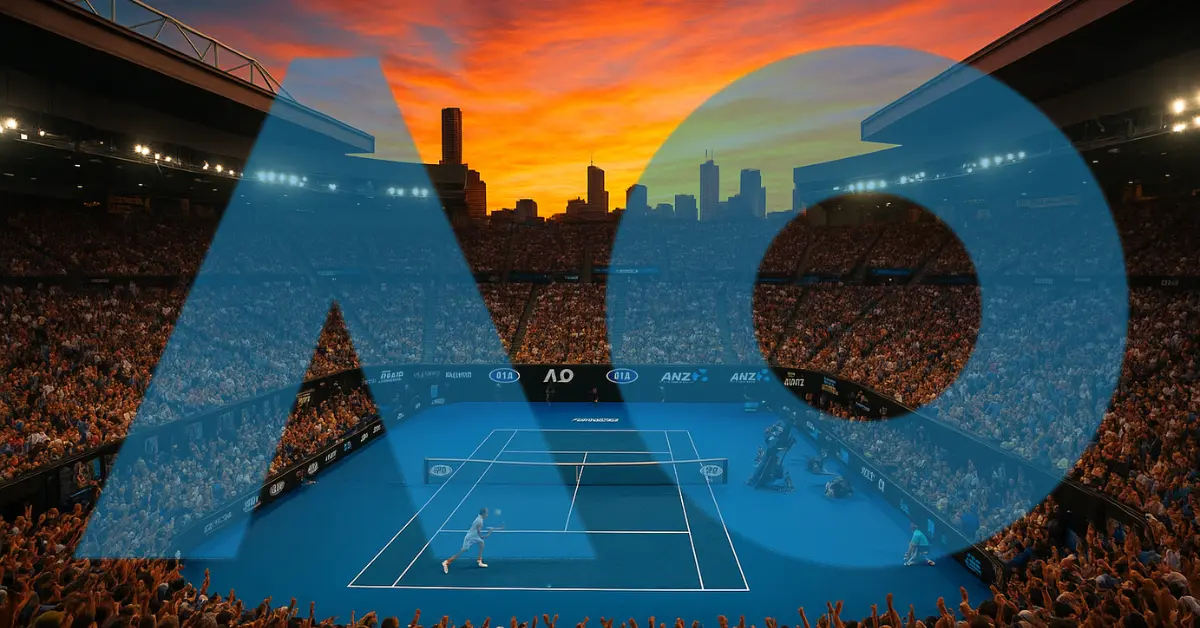Table of Contents
The Australian Open is known to all tennis lovers around the world as one of four Grand Slams in tennis sport and little people know the amazing story that changed this event in sport into a national championship to a sporting event which is followed by people all over the world. Since its humble origins in 1905, the Australian Open has endured the world wars, changing of the venue, change of the surface and scores of epic matches that have molded the history of tennis.
This detailed investigation shows how the great tennis championship of Australia grew out of a mere get-together of local competitors to a multi-million dollar spectacle that brings the world’s top competitors and hundreds of thousands of fans to Melbourne in November each year. A longtime tennis fan, or just intrigued by the history of sport, the Australian Open History has some interesting information on how big sporting events change and survive through the ages.
The story of the tournament includes the technological advances, cultural changes, iconic players, and business developments that reflect the shifts in the professional sports overall. The Australian Open has never been afraid to push the limits in its quest to promote the Southern Hemisphere hosting of a major tournament, and its evolution of new broadcasting methods notwithstanding its original Australian flavor.
Origins and Early Years of the Australian Open History
The Australian open dates back to November 1905 in which the tournament had been conducted under the name of Australasian Championships. This was the first of its type which was held the Cricket Ground at the Warehouseman in Melbourne, with only the men singles and doubles events.
The First Tournament in Australian Open History (1905)
- Date : November 17-20, 1905
- Venue : Warehouseman’s Cricket Ground, Melbourne
- Participants : 17 men competed in singles
- Winner : Rodney Heath (Australia)
- Prize money : None—purely amateur competition
- Surface : Grass courts
At the start of the tournaments, it was still an amateur sport of tennis. Players did not compete to win money but glory and local and regional players were the main participants in the event. Amateur status of the tournament was not changed during decades and it was governed by strict rules of the International Lawn Tennis Federation.
Early Growth in Australian Open History: 1910s and 1920s
Several key developments marked the tournament’s early expansion:
- 1922 : Women’s singles and doubles were added
- 1924 : Mixed doubles competition introduced
- 1926 : The tournament became truly international with overseas players
- 1927 : Name changed from Australasian Championships to Australian Championships
Women events added to the tournament were a major addition and the tournament became more attractive and expansive. The first women singles champion in 1922 was Margaret Molesworth and this set a precedent of powerful Australian women tennis that would last decades.
Evolution into a Major Tournament
The Australian Championships of 1930s was an essential time when the event started becoming a high-end international event. Nevertheless, there were numerous circumstances that prevented its fame worldwide in the beginning.
Geographic Challenges
- Distance : Australia’s remote location made travel expensive and time-consuming
- Scheduling : January dates conflicted with Northern Hemisphere seasons
- Player participation : Many top international players skipped the tournament
- Amateur restrictions : Prize money prohibition limited professional player interest
In spite of this, the tournament progressively acquired a better competition. A 1938 final between Don Budge and John Bromwich in the men singles championship is frequently quoted as the game that declared the Australian Championships as a world tournament.
Impact of World War II on Australian Open History
The tournament faced significant disruption during World War II:
- 1940-1945 : Limited international participation
- 1941-1945 : Reduced to primarily local competition
- Venue changes : Multiple relocations due to wartime restrictions
- Post-war recovery : Gradual return to international status by the late 1940s
The Kooyong Era
Between the years 1972 and 1987, the Australian open was hosted in the Kooyong Lawn Tennis Club in Melbourne. This is a time that tennis purists fondly remember when the club was characterized by a small intimate feel and old-fashioned grass courts.
Kooyong’s Characteristics
- Capacity : Approximately 8,000 spectators
- Surface : Grass courts (maintaining Wimbledon-style tradition)
- Atmosphere : Intimate, club-like environment
- Accessibility : Limited parking and public transport options
- Facilities : Basic amenities by modern standards
Memorable Kooyong Moments
The Kooyong years produced numerous classic matches and breakthrough performances:
- 1981 : Johan Kriek’s back-to-back victories established him as a major force
- 1977 : Vitas Gerulaitis defeated John Lloyd in a five-set thriller
- 1983 : Mats Wilander’s first Grand Slam victory at age 19
- 1987 : Stefan Edberg’s final Kooyong triumph before the venue change
Growing Pains
Despite its charm, Kooyong presented increasing challenges:
- Limited capacity : Unable to accommodate growing crowds
- Infrastructure : Aging facilities required significant investment
- Broadcasting : Poor television angles and limited camera positions
- Commercial potential : Restricted opportunities for corporate hospitality
From Grass to Hard Courts & Melbourne Park
The greatest change in the history of Australian Open was the 1988 move to the Melbourne Park. This action solved several problems as well as put the tournament in a place to expand.
The Melbourne Park Revolution
New Venue Features:
- Capacity : Expandable to over 100,000 daily spectators
- Courts : State-of-the-art hard courts replacing grass
- Technology : Advanced broadcasting capabilities
- Amenities : Modern facilities and corporate hospitality areas
- Accessibility : Improved public transport and parking
Surface Change Impact
The switch from grass to hard courts fundamentally altered the tournament’s character:
Benefits of Hard Courts:
- Consistency : More predictable ball bounces and playing conditions
- Player adaptation : Easier transition from other hard court tournaments
- Spectator experience : Better viewing angles and ball visibility
- Maintenance : Reduced weather-related delays and cancellations
Initial Resistance:
- Traditionalists : Mourned loss of grass court variety
- Players : Required adjustment to different playing style
- Strategy : Baseline play became more prominent than serve-and-volley
Rod Laver Arena and Its Role in Australian Open History
The tournament’s centerpiece, Rod Laver Arena, became synonymous with Australian Open excellence:
- Capacity : 15,000 seats
- Naming : Honored Australian tennis legend Rod Laver
- Features : Retractable roof (added in 2006)
- Technology : Advanced sound and video systems
- Atmosphere : Maintained intimate feel despite larger size
Key Milestones and Innovations
Australian Open has continued to be innovative and has employed innovations that other tournaments have in the future adopted. The developments are the result of the festival focus on enhancing the experiences of players and spectators.
Technological Firsts
- 1988 : First Grand Slam with colored courts (blue)
- 2001 : Introduction of Hawk-Eye electronic line calling
- 2006 : First retractable roof on center court
- 2015 : Extreme Heat Policy implementation
- 2019 : Fast4 format trials for qualifying rounds
Prize Money Evolution
The tournament’s prize money growth reflects its increasing commercial success:
- 1969 : First prize money awarded (professional era begins)
- 1988 : $1.4 million total prize pool at Melbourne Park debut
- 2000 : Prize money exceeds $10 million
- 2019 : Total prize pool reaches $60.5 million
- 2023 : Prize pool exceeds $75 million
Broadcasting Innovations
The Australian Open pioneered several broadcasting techniques:
- Multi-channel coverage : Allowing viewers to choose courts
- Digital streaming : Early adoption of online viewing options
- International partnerships : Expanding global television reach
- Social media integration : Engaging younger audiences through digital platforms
Iconic Players and Records
The Australian Open’s honor roll includes virtually every tennis legend, but certain players have forged special connections with the tournament.
Australian Champions
Rod Laver (1960, 1962, 1969)
- Three singles titles during amateur and professional eras
- Only player to win calendar-year Grand Slams twice
- Tournament’s main arena bears his name
Margaret Court (1960-1973: 11 singles titles)
- Most successful player in tournament history
- Dominated women’s tennis during amateur era
- Court named in her honor at Melbourne Park
Pat Rafter (Never won singles, but beloved figure)
- Reached semifinals multiple times
- Epitomized Australian tennis spirit
- Popular commentator and ambassador
International Legends
Novak Djokovic (2008, 2011-2013, 2015-2016, 2019-2021, 2023)
- Record nine men’s singles titles
- Undefeated in Australian Open finals
- Considers Melbourne Park his favorite venue
Serena Williams (2003, 2005, 2007, 2009-2010, 2015, 2017)
- Seven singles titles spanning 14 years
- Won 2017 title while pregnant
- Dominated during peak years
- Six singles titles
Roger Federer (2004, 2006-2007, 2010, 2017-2018)
- 2017 comeback victory particularly memorable
- Played final Australian Open in 2020
Records in Recent Decades
The modern era has produced remarkable achievements and unforgettable moments at Melbourne Park.
Notable Records
Men’s Singles:
- Most titles : Novak Djokovic (9)
- Longest match : 2012 final – Djokovic defeated Nadal in 5 hours 53 minutes
- Youngest winner : Novak Djokovic (20 years, 250 days in 2008)
- Oldest winner : Roger Federer (35 years, 174 days in 2017)
Women’s Singles:
- Most titles (Open Era) : Serena Williams (7)
- Youngest winner : Martina Hingis (16 years, 117 days in 1997)
- Consecutive titles : Steffi Graf (1988-1990) and Monica Seles (1991-1993, 1996)
Memorable Matches
- 2017 Men’s Final : Federer’s comeback victory over Nadal
- 2009 Men’s Final : Nadal’s emotional first Australian Open title
- 2012 Women’s Final : Victoria Azarenka’s dramatic three-set win
- 2019 Men’s Final : Djokovic’s straight-sets dominance over Nadal
Cultural and Economic Impact
The Australian Open has become far more than a tennis tournament—it’s a cultural institution that significantly impacts Melbourne and Australia’s economy.
Economic Benefits
Direct Economic Impact:
- Annual contribution : Over $387 million to Victorian economy
- Employment : Creates approximately 1,500 temporary jobs
- Tourism : Attracts 800,000+ visitors annually
- Hotel occupancy : Drives peak summer season bookings
- International exposure : Provides global marketing value for Melbourne
Infrastructure Development:
- Melbourne Park improvements : Ongoing facility upgrades
- Transportation : Enhanced public transit connections
- Urban development : Catalyst for broader precinct improvements
Cultural Significance
Australian Identity:
- National pride : Showcases Australian hospitality and organization
- Tennis development : Inspires grassroots participation
- Celebrity culture : Creates annual focal point for entertainment industry
- Fashion showcase : Platform for tennis apparel innovation
International Recognition:
- Tourism drawcard : Major reason for January visits to Australia
- Diplomatic tool : Hosts international dignitaries and business leaders
- Cultural exchange : Facilitates global connections and partnerships
Unique Features in the Evolution of Australian Open History
The Australian Open has developed distinctive characteristics that set it apart from other Grand Slam tournaments.
The “Happy Slam” Atmosphere
Several factors contribute to the tournament’s reputation as the most relaxed and enjoyable Grand Slam:
- Weather : Consistent summer conditions create outdoor festival atmosphere
- Fan interaction : More casual, approachable environment for player-fan engagement
- Entertainment : Extensive off-court activities and live music
- Food and beverage : Diverse culinary options reflecting Melbourne’s multicultural character
- Operating hours : Extended daily schedules accommodate global television audiences
Technological Leadership
Heat Management:
- Extreme Heat Policy : Pioneered systematic approach to player safety
- Cooling systems : Advanced air conditioning in covered courts
- Medical protocols : Comprehensive heat-related illness prevention
Fan Experience:
- Australian Open app : Comprehensive digital companion
- Virtual reality : Immersive viewing experiences
- Social media walls : Real-time fan content integration
- Live streaming : Multiple court options for global audiences
Environmental Initiatives
- Sustainability programs : Waste reduction and recycling initiatives
- Water conservation : Efficient irrigation systems
- Energy management : Solar power integration and LED lighting
- Carbon offsetting : Comprehensive environmental impact mitigation
Challenges and Triumphs Throughout Australian Open History
Throughout its history, the Australian Open has faced numerous obstacles while achieving remarkable successes.
Ongoing Challenges
Geographic Isolation:
- Travel costs : Expensive for international players and media
- Time zones : Challenging for global broadcasting optimization
- Seasonal timing : Conflicts with Northern Hemisphere winter holidays
Climate Concerns:
- Extreme heat : Annual management of dangerous temperature conditions
- Air quality : Bushfire smoke impacts (notably 2020 qualifying rounds)
- Weather delays : Occasional rain disruptions despite covered courts
Competition from Other Events:
- Prize money arms race : Keeping pace with other Grand Slams
- Player appearance fees : Attracting top stars despite travel demands
- Scheduling conflicts : Managing calendar coordination with ATP and WTA
Success Stories
Facility Excellence:
- Melbourne Park expansion : Continuous improvement of tournament facilities
- Spectator capacity : Successfully accommodating growing attendance
- Player amenities : World-class practice and recovery facilities
Global Reach:
- Television audience : Consistent growth in international viewership
- Digital engagement : Leading social media presence among Grand Slams
- Corporate partnerships : Strong commercial relationships with global brands
Looking Ahead: The Future of Australian Tennis
The Australian open has undergone an amazing journey of being a small amateur tournament to a world sporting event, and this is a testimonial of what vision, adapting and commitment to excellence can do. With the tournament coming to celebrate its 120th anniversary, there are a number of trends that will determine the further development of the tournament.
The Melbourne Park era is a testament to the fact that sometimes risky moves such as changing beloved home Kooyong can produce transformational effects. Technological innovation in the form of colored courts and retractable roofs among other technology elements used in the tournament made it a leader as opposed to a follower in the field of tennis development.
Perhaps the last, but most importantly, the Australian Open has managed to retain the unique nature of its character and accept the changes in order to keep it relevant, which can be learned by all major sporting events. The atmosphere of the Happy Slam, defined as a serious sport competition and true Australian hospitality, produced a unique brand that was familiar around the globe to players, fans and media.
The economic effect of the tournament is much broader than two weeks in January and includes year-round jobs, tourism and international reputation of Melbourne and Australia. With the sport of tennis having expanded all over the world, the Australian open is at the right position to remain one of the major events in the sport.
The challenges that will be had in the future will involve adjusting to the effects of the climate change, dealing with the growing commercial pressures and ensuring that competitive balance is kept with other Grand Slams. Nevertheless, the story of successful adaptation of the tournament indicates that it will keep seeking solutions to the problems and still maintaining the necessary factors that make the Australian Open unique.
The Australian Open history is being written with every passing tournament, but its basis, constructed in the course of the world tennis competition, the innovations and the memorable moments – the history of the tournament of the kind will make sure that this great event will even to more people inspire the participants and spectators of the sport in the future.

Saurabh is a passionate tennis content writer and lifelong fan of the game. Whether it’s Grand Slam showdowns or under-the-radar rising stars, Saurabh brings the court to life with sharp analysis, breaking news, and deep-dive features. When they aren’t covering matches, you can find them practicing their topspin forehand or debating who is the GOAT over coffee. Do you enjoy tennis? Then you are in the right place.




